Vol 3 No. 32 TROPIC LIGHTNING NEWS August 5, 1968
Index
On
Nui Ba Den:
Pilot Risks Life To Rescue
a LRP
By 1LT Jim Leman
CU CHI - The toe of the light observation
helicopter’s right skid perched precariously on a boulder. The rotor blade
chomped furiously at nearby trees. The chopper’s body hung menacingly to the
cliff’s edge.
At the base of the cliff nestled a Viet Cong base camp. The six-man long
range patrol (LRP) realized their fate hung on the cliff with the chopper. They
were out of food and water, and the VC knew they were there.
The series of events bringing the courageous pilot to this perilous
mountainside began four days earlier when a 25th Infantry Division patrol left
the U.S. base on the 3,200-foot summit of Nui Ba Den in Tay Ninh Province.
Their mission: to gather intelligence as they moved down the 45-degree,
enemy-infested slopes and call for extraction two days later in the rice paddies
at the base of the mountain.
On the second day, the men neared the bottom only to find their planned exit
blocked by a VC base camp. “We couldn’t get through ‘Charlie’ so we tried to go
back up and around and come down again,” explained Sergeant Willard R. Ethridge,
19, of Atlanta, leader of the F Company, 50th Infantry, patrol.
They tried . . . once, twice, three times. Each time they ran into Charlie.
Finally, on the third day, they stopped in a rocky gulch one-third up the
mountain and radioed for help. One man’s leg had been injured by a falling
rock. Another man had suffered heat exhaustion.
“We were out of food and water. When it rained we would catch the water
running off the rocks in our canteens - a little dirty, but it was good,”
recalled Specialist 4 Joseph Hitchens, 20, of New Orleans.
Two other LRP’s at the foot of the mountain started moving toward the trapped
patrol. They both ran into enemy .50 caliber machine gun and rocket grenade
fire and had to be extracted.
A 25-man reactionary force from F Company got 200 meters up the mountain
before nightfall. The next day they tried to reach their beleaguered buddies
but got pinned down in a fire fight with the VC.
It looked bleak for the LRP.
(Continued On Page 8)
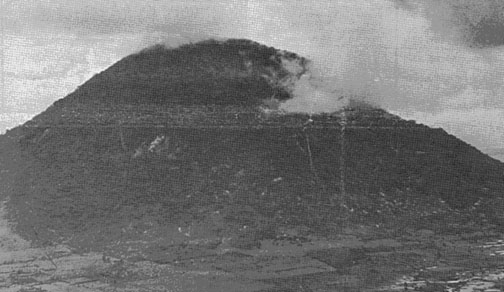 |
| NUI BA DEN - Shrouded by clouds and mist juts abruptly from the rice paddies 51 miles northwest of Saigon. It was here, on the mountain’s rugged slopes, that the six man LRP patrol clung to a ledge above a VC base camp for four days before being rescued by a light observation helicopter. |
Soldier Spots Enemy
Troop On 1st Ambush
1ST BDE - An alert infantryman on his first
night ambush detected a lone Viet Cong soldier trying to sneak past his
position. As a result of the “green horn’s” sharp eyes, there is one less enemy
to worry about.
The 3d Platoon of Company D, 2d Battalion, 14th Infantry, had just stopped
and set up for the night. While arrangements were being made for guard, Private
First Class Fred Lee of Decatur, Mich., spotted the Viet Cong coming down the
trail.
“He was stooped over, walking low to the ground and with the use of a
starlight scope I could see his web gear and weapon,” said Lee.
The men waited until the Viet Cong, unaware his presence was known, stopped
near a claymore mine. The Golden Dragon troopers detonated the mine killing the
intruder.
Dragons Drive Nets
Weapons When VC Flee
CU CHI - A hastily-abandoned enemy bunker line
was the scene of a large cache of weapons and equipment captured by a 25th
Infantry Division rifle company five miles northwest of Saigon.
Company C, 2d Battalion, 14th Infantry, came upon the 1000-meter line of Viet
Cong fortifications while on a reconnaissance in force sweep during Operation
Toan Thang II.
“When we first came to the bunker line, we got on line and reconned the area
by fire,” said Private First Class William Reams, of Marina, Calif. “They must
have left in a hurry, because they left behind a lot of valuable medical
supplies,” added Reams, the 3d Platoon medic.
After security was set up, the men were split into search teams. A thorough
search of the area resulted in the collection of several weapons and equipment
left by the retreating Viet Cong after air strikes had almost completely
destroyed their fortifications.
Items found in the cache include: a medical kit consisting of a scalpel, 3
hemostats, scissors, drugs; 5 AK-47 assault rifles, 11 RPG rounds and boosters,
11 82mm mortar rounds, and 300 rounds of AK-47 ammunition. The Dragon troopers
also recovered an M-79 grenade launcher with 30 rounds.
Tomahawk’s Drive Clears
Regimental Size Camp
1ST BDE - An attack by the Viet Cong on 25th
Infantry Division infantrymen enroute to set up a night location yielded
fourteen enemy killed and a regimental size base camp destroyed.
As B Company, 4th Battalion, (Mechanized), 23d Infantry started to move
toward a village 24 kilometers southeast of Tay Ninh, they saw a mass exodus of
civilians rapidly departing, carrying as much of their personal baggage as
possible. First Lieutenant Morgan Sincock of Natick, Mass., the company
commander, immediately relayed the information to Lieutenant Colonel Clifford
C. Nielson, of Mobile, Alabama, the Tomahawk battalion commander.
“I knew that there had to be VC in the village, so I dismounted my men off
the armored personnel carriers and advanced but a few meters before we were
being hit from all sides,” recalled Sincock.
Because of the heavy base of suppressive fire, the company withdrew to
another flank where they were greeted with a heavy concentration of RPG fire.
Lt. Col. Nielson, flying overhead, instructed B Company to hold in place
until C Company, commanded by Captain Henry Phillips of Columbus, Ga., arrived
to reinforce. As C Company arrived, their .50 caliber machine guns barked a
heavy volume of fire and the tension was eased. Lt. Col. Nielson then
dispatched Company A, commanded by Captain Henry Montgomery of Memphis,
Tennessee, to make a daring assault on the enemy’s blind side.
“We thought that the two other companies had Charlie’s attention and we could
sneak up on him before he knew what was happening,” remarked First Lieutenant
Danny L. Blake of Baltimore, Md., 2d platoon leader of Company A. The enemy
base camp was much larger than expected and A was greeted with a combination of
automatic weapons and RPG fire.
All three companies withdrew and formed a horseshoe cordon of the enemy
infested village. An ARVN element from Go Dau Ha was dispatched and completed
the seal of the village. The VC were helplessly trapped and a light fire team
of Huey AH1-G Cobras from C Troop, 3d Squadron, 17th Air Cavalry’s base camp at
Di An peppered the expected bunker positions with ten sorties of rockets and
mini-guns.
Colonel Freemont B. Hodson of Greeneville, S.C., the 1st Brigade commander,
was now calling the shots from the air as Lt. Col. Nielson withdrew to refuel
his C&C ship. Col. Hodson’s Huey made low sweeps over the village, hoping to
dislodge the trapped enemy, but the enemy was determined and refused to budge.
After an artillery barrage by the 3d Battalion, 13th Artillery and 7th
Battalion, 11th Artillery, a two pronged attack was attempted.
As Company A advanced closer to the village, they were all poised and waiting
for everything to start again. “That assault to the village made me feel what
anxiety really is,” stated Specialist 4 Thomas F. Donohue of Brooklyn, N.Y. But
they received no enemy fire and advanced slowly, destroying bunkers, spider
holes and other fighting positions.
The enemy had gathered forces and in desperation, opened up with everything
they had on C Company, who was advancing from another flank. Again Col. Nielson
directed gunships and artillery from the air.
With darkness rapidly closing in, the Tomahawks set up two separate night
locations which still had the enemy sealed on three sides. All night artillery
pounded the uncovered side of the village to prevent the enemy’s escape by
night.
The sweep was made with no enemy resistance. A total of 14 enemy were killed
and over 150 bunkers were discovered and destroyed in the regimental size base
camp.
Page 2 TROPIC LIGHTNING NEWS August 5, 1968
Decorated
| AIR MEDAL FOR HEROISM | |
|
COL Raymond O. Miller, HHC, 2nd Bde LTC John J. Walsh HHC, 2nd Bde MAJ Marvin C. Layfield, HHD, 25th Avn Bn CPT Ronald M. Howard, HHC, 1st Bde, 25th Inf Div |
1LT Christopher C. Straub, HHC SP4 Donald Anderson, Co B, 25th Avn Bn SP4 Todd R. Murphy, Co A, 25th Avn Bn SP4 Samuel A. Haile, Co A, 25th Avn Bn |
|
DISTINGUISHED FLYING CROSS |
|
|
CPT Michael J. Stephen, Co A, 25th Avn Bn CPT James A. Howd Jr., Co A, 25th Avn Bn CPT James R. Jempson, Co A, 25th Avn Bn |
WO1 Thomas V. Meeks, D Trp, 3d Sqdn, 4th Cav WO1 David W. White, Co A 25th Avn Bn |
|
SILVER STAR |
|
|
CPT Harry K. Jowers, C Btey, 7th Bn, 11th Arty CPT William O. Coomer, A Trp, 3d Sqdn, 4th Cav 1LT Robert H. McLaughlin, C Btry, 7th Bn, 11th Arty 1LT George W. Vessell, Co B, 4th Bn, 9th Inf 2LT William J. Cooper, Co D, 3d Bn, 22nd Inf SFC Jesse W. Frier, HHC, 4th Bn, 23d Inf SSG Earl Thomas, Co C, 2nd Bn, 27th Inf SSG Charley M. Fry, H,HB, 7th Bn, 11th Arty |
SGT Noel F. Marsh, A Btry, 1st Bn, 8th Arty SGT Harry E. Schreyvogel, C Trp, 3d Sqdn, 4th Cav SP5 John C. White, C Trp, 3d Sqdn, 4th Cav SGT James J. Merry, Co B, 1st Bn, 5th Inf CPL Stanley Wojciechowski, C Btry, 7th Bn, 11th Arty SP4 William J. Moulds, A Btry, 3d Bn, 13th Arty SP4 James E. Lynch, Co A, 2nd Bn 27th Inf SP4 Rodney D. Wynn, Co D, 2nd Bn, 27th Inf |
|
BRONZE STAR |
|
|
MAJ Larry G. Quinn, HHB, 7th Bn, 11th Arty, 25th Inf Div CPT David R. Schucker, A Btry, 7th Bn, 11th Arty, 25th Inf Div 1st Lt James E. Collinson, Co A, 2nd Bn, 14th Inf, 25th Inf Div 1st Lt Charles E. Jiron, Co D, 2nd Bn, 27th Inf, 25th Inf Div 1st Lt Stanley K. Fornander, A Trp, 3d Sqdn, 4th Cav, 25th Inf Div 1st Lt James E. Collinson, Co A, 2nd Bn, 14th Inf, 25th Inf Div 2nd Lt Harold R. Kain, HHB, 3d Bn, 13th Arty, 25th Inf Div SSG James M. Whitfield, Co D, 1st Bn, 27th Inf, 25th Inf Div SSG Fiancis R. Omboy, Co D, 4th Bn, 9th Inf, 25th Inf Div SGT Leonard C. Bartlette, A Btry, 3d Bn, 13th Arty, 25th Inf Div SGT Jerry L. Porter, A Btry, 3d Bn, 13th Arty, 25th Inf Div SGT James W. Pruett, A Btry, 3d Bn, 13th Arty, 25th Inf Div SGT Ernest R. Bridwell, Co D, 4th Bn, 9th Inf, 25th Inf Div SP5 John C. White, C Trp, 3d Sqdn, 4th Cav, 25th Inf Div |
SP5 Ralph E. Kays, 3d Bn, 13th Arty SP5 Robert G. Meendering, Co D, 65th Engr Bn CPL Thomas W. Hall, B Btry, 6th Bn, 77th Arty CPL Alfred T. Hofweber, B Btry, 6th Bn, 77 Arty SP4 Arthur T. Mcnally, HHC, 4th Bn, 23d Inf SP4 James E. Kelly, HHB, 3d Bn, 13th Arty, SP4 John W. Arentz, Co D, 4th Bn, 9th Inf SP4 Lawrence Cunningham, C Btry, 3d Bn, 13th Arty SP4 William L. Thomas, B Btry, 6th Bn, 77th Arty SP4 Albert J. Porter, C Trp, 3d Sqdn, 4th Cav SP4 David C. Ferguson, HHC, 4th Bn, 23d Inf SP4 Charles F. Day, Co D, 65th Engr Bn SP4 William C. Fee, A Btry, 3d Bn, 13th Arty SP4 Ruben J. Salazar, C Btry, 7th Bn, 11th Arty |
|
ARMY COMMENDATION MEDAL (HEROISM) |
|
|
PFC David J. Boiling, C Btry, 7th Bn, 77th Arty PFC David C. Laf crest, C Btry, 7th Bn, 11th Arty PFC James Belmudez, C Btry, 7th Bn, 11th Arty PFC Eugene Anhault, C Btry, 7th Bn, 11th Arty PFC John Coveleskie, Co D, 2d Bn, 14th Inf PFC Thomas Ebanez Jr., Co B, 3d Bn, 22d Inf PFC Pasquale V. Zaza, Co B, 3d Bn, 22d Inf PFC Donald L. Wall, B Trp, 3d Sqdn, 4th Cav PFC Charles R. Putman, Co B, 3d Bn, 22d Inf PFC Dennis E. Tveter, Co B, 3d Bn, 22d Inf PFC Louis E. Turcotte, B Trp, 3d Sqdn, 4th Cav |
PFC Joe L. Jones, HHT, 3d Sqdn, 4th Cav PFC Gary W. Ludwig, Co D, 2d Bn, 14th Inf PFC Joel D. Goodwin, HHC, 1st Bn, 27th Inf PFC Charles W. Richards, Co A, 1st Bn, 27th Inf PFC Dennis W. Phelps, Co B, 3d Bn, 22d Inf PFC Gary D. Hayes, Co B, 3d Sn, 22d Inf PFC Richard J. Lloyd,’ B Trp, 3d Sqdn, 4th Cav PFC Albert Elam, B Trp, 3d Sqdn, 4th Cav PFC Henry R. Richardson, Co B, 4th Bn, 9th Inf PFC Ronald W. Harrig, Co B, 3d Bn, 22d Inf PFC Paul E. Gipson, Co B, 3d Bn, 22d Inf |
Adjutant General’s Office Has Final Say on
Leave
The authority for granting emergency leaves to military personnel has been
delegated by the Dept. of Defense to the commanding generals of the major
commands.
The emergency leave program at Division Headquarters is administered by 25th
Infantry Division’s Adjutant General’s Office. The Red Cross field director
does not have the authority to grant or deny emergency leaves.
Emergency leaves are usually granted by commanders whenever death or critical
illness occurs in a serviceman’s immediate family which requires his presence at
home.
“Immediate family” means a serviceman’s parents, brother, sister, wife or
child. It does not include a grandparent or other distant relative unless that
relative acted in “loco parentis”; that is, assumed full legal responsibility
for a serviceman’s rearing in place of the parent.
The Red Cross field director will attempt to verify emergencies at home upon
the request of a serviceman or his commanding officer. Verifications, together
with doctor’s recommendations (where applicable), are obtained through the
American Red Cross chapter located in the serviceman’s home town. The
information is cabled back to the field director who passes it on to the
serviceman and his commanding officer.
Because of time and distance factors involved, every serviceman would be wise
to advise his family to contact the local Red Cross chapter promptly should an
emergency develop which requires his presence. In this way, the emergency can
be verified and reported to the field director with minimum delay.
Red Cross financial assistance in amounts sufficient to pay the cost of round
trip air transportation from the stateside port to the hometown is available
from the Red Cross to personnel on emergency leave.
The military man should discuss these financial matters with the field
director before his departure to the United States.
|
Take A Hint G.I.! |
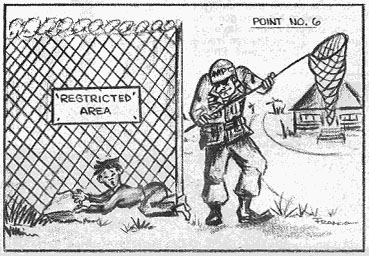 |
| Be alert to security and ready to react with your military skill . . . |
Uncle Sam Was A Real Person
Samuel Wilson, a native of Arlington, Massachusetts, was affectionately
called “Uncle Sam” by his friends.
A meat packer and inspector in later life, he was inspector of supplies for
the government during the War of 1812 and stamped all that he inspected “U.S.”
for United States.
The soldiers began referring to items so marked as belonging to “Uncle Sam.”
In the beginning he was clean shaven, wearing a tail coat and top hat.
Cartoonists added red pants during Andrew Jackson’s presidency and during the
Civil War, they grew him a beard.
Thus a symbol of the United States as true to Americans as Santa Claus is to
Christmas was born. Yes, Uncle Sam was a real person!
Do Not Use Captured Weapons: They Explode
In recent months several incidents have been reported to COMUSMACV concerning
CHICOM AK-47s which have exploded in use.
Technical intelligence brief 2-68 explains in detail two early incidents and
contains a comprehensive technical analysis of the possible causes of failures
as well as the resulting injuries to the users.
MACV Directive 381-24 prohibits use of the captured weapons and munitions.
Chief among the reasons for this is the fact that the degree of quality control
exercised in the manufacture of Communist Bloc arms varies from excellent to
poor. The allied soldier who uses a captured weapon is gambling that it will
not blow up in his face, causing either serious injury or death.
Secondly, retention of these weapons by the individual deprives allied
agencies of information required for technical intelligence purposes, which in
turn benefits every soldier in the field. (MACV)
Gama Goat Will Phase Out Old 3 /4 Ton Trucks
The first member of a new family of high-mobility military vehicles is now
being manufactured for the U.S. Army and the Marine Corps.
A production contract for the M-561 one and one quarter ton GAMA GOAT has
been awarded to the Consolidated Diesel Electric Co. which will manufacture
about 13,000 vehicles for the Army and 2,000 for the Marine Corps.
Scheduled to replace the M-37 three quarter ton truck and trailer in forward
areas, the GAMA GOAT is a separate tractor and carrier connected so that power
is transmitted to the carrier wheels.
In addition to high cross-country mobility, the vehicle can swim or be
airdropped with a full load. (ANF)
The TROPIC LIGHTNING NEWS is an authorized publication of the 25th
Infantry Division. It is published weekly for all division units in the Republic of
Vietnam by the Information Office, 25th Infantry Division, APO San Francisco
96225. Army News Features, Army Photo Features, Armed Forces Press Service and Armed
Forces News Bureau material are used. Views and opinions expressed are not necessarily
those of the Department of the Army. Printed in Tokyo, Japan, by Pacific Stars and
Stripes.
MG Ellis W. Williamson . . . Commanding General
MAJ Andrew J. Sullivan . . Information Officer
2LT Don A. Eriksson . . . . . Officer-in-Charge
SP4 Stephen Lochen . . . . . Editor
SP4 Bill Berger . . . . . . . . . . . Editorial Assistant
Page 3 TROPIC LIGHTNING NEWS August 5, 1968
While you serve on a permanent duty assignment outside of the United States
or its possessions, you may take advantage of the lucrative Dollar Saving
Program.
You may make deposits in amounts of $5.00 or more and in multiples of $5.00
as long as you do not exceed your unalloted current pay and allowances each
month. Deposits may include reenlistment bonuses, travel allowances on
discharge and pay and allowances used for unaccrued unused leave.
Advance pay and travel allowances on PCS and TDY are excluded.
METHODS OF DEPOSIT
Deposits may be made by allotment or by cash and check deposits.
Class S allotments for a specific amount per month (in multiples of $5.00)
may be initiated at the finance office servicing your unit.
Cash or check deposits may be made at the servicing finance office during
normal hours of operation. Cash deposits may be accepted by an officer
appointed by unit commanders in accordance with the provisions of 25th Infantry
Division Regulation 643-3.
Those cash deposits received before the 10th of the month will earn interest
from the beginning of the month. Those deposited after the 10th, earn interest
from the 1st of the next month.
Cash deposits are limited to $200 or less, unless the deposit is made
simultaneously with receipt of pay and allowances. Deposits larger than $200
may be made by personal check made payable to the Treasurer of the United
States.
ACCUMULATION OF INTEREST
Interest accrues at a rate of 10% per annum, compounded quarterly, according
to calendar quarter.
Quarterly interest is computed at 2.5% on the average quarterly balance in
the deposit. Interest is paid only upon request for final repayment of Savings
Deposit. In no case will interest accrue for a period longer than 90 days
(computed on a day to day basis of actual elapsed time) after the serviceman
returns to the Unites States or its possessions.
Except where the 90 day limit applies, interest will stop at the end of the
month in which full repayment is made to the member or his heirs. There is no
limit on the amount which a member may accrue on his accounts, however, interest
is paid on the following deposits:
10% on amounts up to and including $10,000.
4% on amounts in excess of $10,000, including new deposits and/or accumulated
interest which have been credited since August 14, 1966.
Questions and
Answers About Savings Bonds
EDITOR’S NOTE - Series E and H Savings
Bonds and Freedom Shares have become more attractive savings investments.
Effective June 1, the interest rates on E and H Bonds increased from 4.15 to
4.25 per cent - the full legal limit. The Freedom Shares (U.S. Savings Notes)
increased from 4.74 to five per cent. In each case, the interest is reflected
as a bonus at maturity. Here are some of the questions and answers concerning
the new policy.
Q. Is it now possible to buy a Freedom Share if a Savings Bond is bought
with it?
A. Yes. As of June 1, a Freedom Share may be bought at a local bank,
without signing up to become a regular purchaser, if a Savings Bond (Series E)
is bought at the same time.
Q. Can a $100 Freedom Share and a $25 Bond be bought?
A. No. But the order can be reversed, the Series E Bond necessarily of the
same size or larger than the Freedom Share.
Q. Will old Bonds now pay more?
A. Yes. Outstanding E and H Bonds will return comparatively higher yields
for the time remaining to next maturity. This increase will be realized only in
the final interest period when Bonds are held to maturity.
Q. Is it necessary to hold Bonds to maturity in order to get the higher
rate?
A. Yes. It acts like a bonus, realized either at original maturity or
extended maturity.
Q. What about the higher rate on outstanding Freedom Shares?
A. The Treasury has no legal authority to increase interest rate on shares
issued between May 1, 1967 and May 31, 1968. They fall under a different law
than do bonds.
Q. Would it pay more to cash in old Freedom Shares and buy the new five per
cent ones?
A. No. Freedom Shares are not redeemable the first year. After that, they
return an average of 4.95% for the remaining three and a half years. The
difference is only pennies, when compared with five per cent for four and a half
years.
Q. Haven’t the maturities on new Bonds usually been shortened when interest
rates were increased?
A. Yes, but not with the new Bonds. Maturities remain the same.
Q. How do you benefit from the higher interest rates if maturities are not
shortened?
A. You receive more than the stated amounts shown on the face of the new E
Bonds and Freedom Shares. It is the same plan as the one used for the 1959 and
1965 increases.
Q. How much more will you receive?
A. A $100 Freedom Share and a $100 Savings Bond (Series E) bought in June
would mature as follows. The Freedom Share, originally $81.00, would be worth
$101.16 after four and a half years. The E Bond, costing $75.00, would be worth
$100.64 after seven years.
Q. Can as many Freedom Shares be bought as often as desired, as long as a
Bond is bought with it?
A. No. The Freedom Share limit is $350 each calendar quarter, and an annual
limitation of $1,350, face value.
In answer to a few last questions, husbands and wives may each buy up to $350
in Freedom Shares per quarter. There is no quarterly restriction on Bonds but
an annual limit of $20,000 face value on E Bonds and $30,000 face value of H
Bonds.
If buying Freedom Shares on the Payroll savings plan, you are limited to
$40.50 each semi-monthly period, $20.25 on a weekly pay plan, $40.50 biweekly
and $81.00 per month.
You must report both interests for income tax purposes, if any report is to
be made at all. You may, as is the case with Bonds, defer reports of Freedom
Share interest until maturity or redemption occurs.
|
Repayment Choice On Bank Deposits |
Start Saving Now
through Savings Bonds
or by Bank Deposit.
No where else can you get the returns
for your money than here!
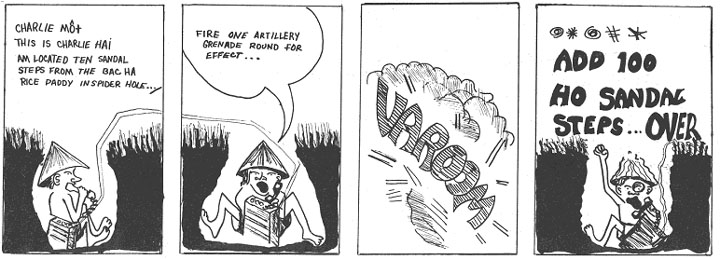 |
Page 4-5 TROPIC LIGHTNING NEWS August 5, 1968
CU CHI - Compare the times, man!
Remember childhood? About 10-15 years ago (for most of us), when the heat
and humidity of the summer’s day would eat away at your vacation enthusiasm.
You’d turn to your buddy with your head hanging and a beat-up sneaker kicking
some dirt and ask that classic question of boredom: “Well Butch (there was
always a Butch), what are we gonna do today?”
That was years ago!
Now you’re in another summer. You’re in an entirely different situation.
Your responsibility lies in helping a country struggle for its freedom, and it’s
by no means a vacation.
There may not be a Butch anymore and there’s certainly very little time for
boredom.
As it stands, your spare time is that break during the 26-hour day between a
sweep and a night ambush patrol. And if the bluebird of fertile rice paddies
smiles at you, your company might stay back a whole day.
When the spare time does come around, there’s no head-hangin’, dirt-kickin’
“what are we gonna do?” scenes.
For the GI in the field, a break is that golden opportunity to make a meal of
the contents of the goodie package that came in the mail (maybe a week ago).
After the care and cleaning of your weapon, it’s a chance to clean the prized
captured rifle.
A break is the time to give Mom and Dad a written pep talk, give your woman
back home words of encouragement – hold on, baby! It’s also the time to read
mail, re-read back mail or dream through those photos you’ve fingered to death.
If you choose to ease your mind, you’ll find a shady spot and do some quiet,
relaxing reading.
The firm believers of “cleanliness is next to . . . having a cold beer,” will
undoubtedly make good use of the bucket plumbing to loose a layer of dirt.
There’s another option, sleep – oooh, sleep.
And finally, if all other fails and boredom is on the brink of setting in,
remember 10-15 years ago; compare the times, man. You’re guaranteed a good
laugh.
Story And Photos By SP4 Larry Weist
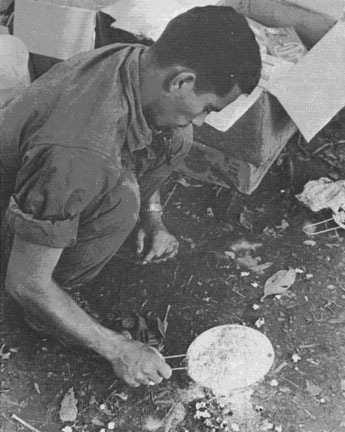 |
POPPING - A package from home brings popcorn which is hastily prepared by Sergeant Roberto Delvalle of Lorain, Ohio. Delvalle is a recon sergeant with Company D, 2d Battalion, 14th Infantry. |
| COOKING - Dishing up freshly fried bacon is Sergeant Luke Bearden, of Odessa, Texas, with the 4.2-inch mortar section of the 2d Battalion, 14th Infantry. |
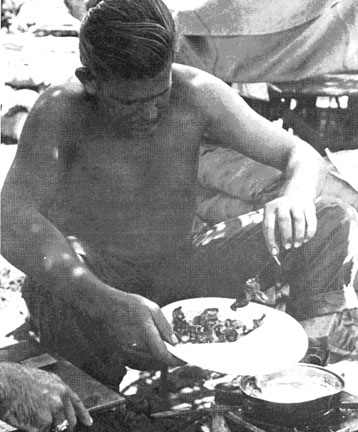 |
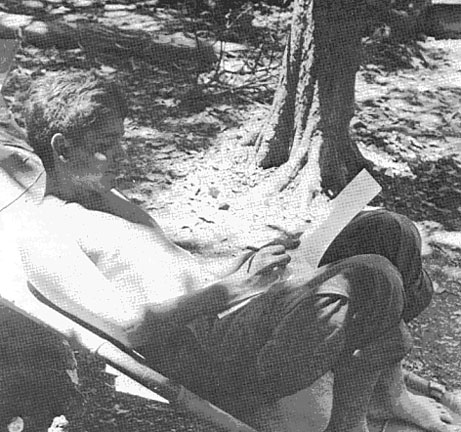 |
WRITING - Specialist 4 Andrew Maldonado, a medic from Buttonwillow, Calif., takes advantage of a few spare minutes to catch up on letter writing. |
| SHOWERING - An improvised shower with cool and cold flowing water, provides a rare treat for Platoon Sergeant Mercer Taylor of Augusta, Ga. |
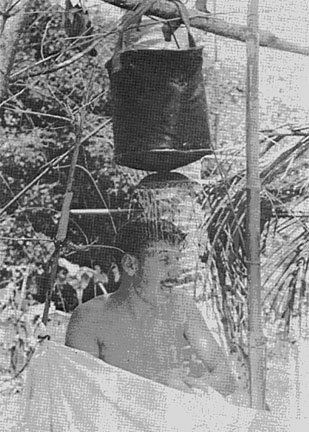 |
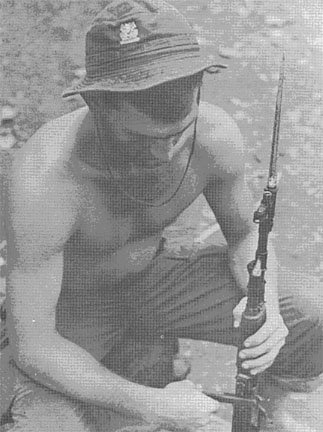 |
CLEANING - Private First Class George Treadwell of Collierville, Tenn. finds time at the end of the day to clean an AK-50 he found while on a sweep mission. |
| READING - Private First Class Austin Jones, of Richmond, utilizing a shady spot, reads the scriptures during a quiet afternoon. |
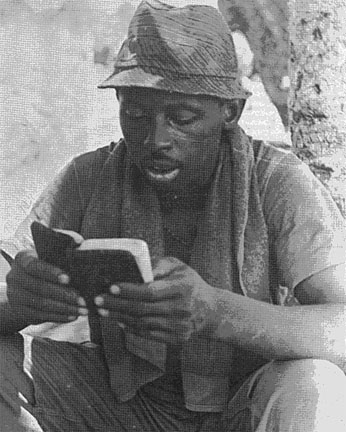 |
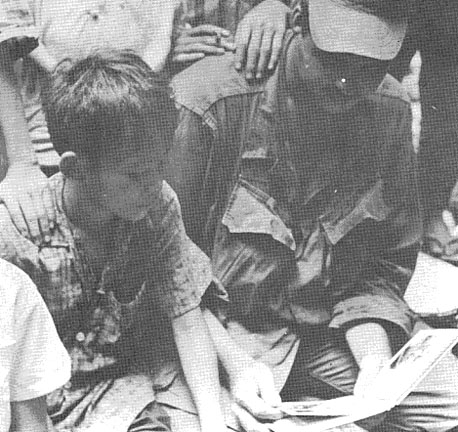 |
SHARING - With friendly Vietnamese children looking on, Specialist 4 Roger Whitaker of Sepulveda, Calif., takes a break from action to took at some photos from home. |
| SLEEPING - A hammock strung between two shade trees is a good place to catch a couple of winks. Enjoying the break is Specialist 4 Benjamin Makuta of Santa Monica, Calif. |
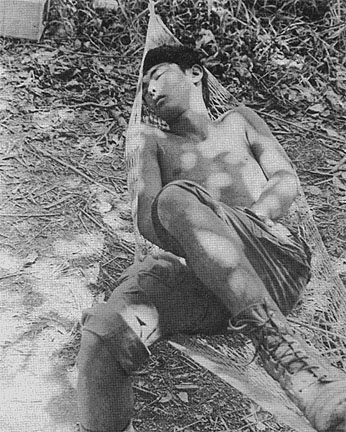 |
Page 6 TROPIC LIGHTNING NEWS August 5, 1968
Nails, Not Needles For
2/22 Medics
3D BDE - Trading their pills for saw and hammer,
the Medics of the 2d Battalion (Mech), 22d Infantry built themselves an Aid
Station at the 3d Brigade, 25th Infantry Division base camp at Dau Tieng.
Formerly the Battalion’s Aid Station had been housed in a large field tent
which proved to be inadequate. So, plans were laid for the construction of a
new permanent type Aid Station. After the engineers laid the concrete floors
and erected the walls, the Medics took over to finish the job to suit their
needs. The work team, led by Specialist 5 Denny Head of Paris, Texas, and
Specialist 5 Carl Mtrey of Northfield, Ohio, built the interior and installed
the wiring and running water. In addition to a large, well-lit treatment area,
the building has a reception and waiting area, pharmacy, and medic’s lounge.
Also, office and living quarters were built for the Battalion Surgeon, Captain
Donald L. Wilson of Morgantown, Indiana.
In addition to the building, the Medics constructed a large storm shelter
type bunker, which has the facilities to be employed as an emergency treatment
room if needed.
After completion of the construction, the building was dedicated to the
memory of those medics who gave their lives in Viet Nam.
 |
| MECH TAKES TO THE AIR - Troops of the 1st Battalion (Mechanized), 5th Infantry, leave their armored personnel carriers behind and charge from choppers to search a suspected enemy-infested area. (PHOTO BY SP4 DON MOUSSEAU) |
Wrecked Road Repaired,
Severed Village Saved
CU CHI - The men of C Company, 65th Engineer
Battalion restored a small isolated village’s link with the rest of the world
when they repaired a road left impassable as a result of the war.
The 2d Brigade engineers, supervised by First Lieutenant Gary L. Reynolds and
Staff Sergeant Richard Piver, repaired the damage and installed culverts to aid
in the drainage.
Although hampered by rain which turned the fill dirt into mud as they worked,
the project was completed in three days.
The road to Nhi Binh was officially opened during a ribbon-cutting ceremony.
Colonel Raymond Miller, 2d Brigade commander, and Major Nguyen Van Hoa,
Vietnamese Army district chief, spoke briefly before they shared the honors of
cutting the ribbon allowing the first truckload of supplies to move down the
road.
Colonel Miller told the crowd that “the road to Nhi Binh was, as far as road
construction goes, not a big project but it is one step in the repair of a
war-torn country.”
Colonel Miller also reaffirmed the 2d Brigade’s support of ARVN troops and
vowed continued civic action projects.
Following the official opening, Colonel Miller traveled down the road and
visited the village of Nhi Vinh. During his visit he saw a MEDCAP being held by
the 2d Brigade’s support of Wolfhounds, and he also inspected the repairs on the
village school by 2d Brigade civic action personnel.
Viet Turns In A
Machine Gun
2D BDE – “When I looked up and saw that man walk
around the back of his house carrying a machine gun, I didn’t know what to
think,” recalled Private First Class John H. Yeder, Newport News, Va.
Yeder, a medic with Company A, 2d Battalion, 14th Infantry, was writing a
letter when suddenly a Vietnamese man walked up to him with a machine gun in
hand.
“I called for my platoon leader, and he came with the field first sergeant,”
said Yeder.
The trio approached the civilian and inquired about his machine gun. It
seems that he found the weapon near his rice paddy and wanted to clean it before
presenting it to Yeder.
Earlier in the week, Yeder had participated in a 25th Infantry Division
medical civic action mission in the village and won the respect of the people
while treating them.
 |
NATURE LOVER - Virna Lisi is a good example of “what it’s all about” in Warner Brothers’ film, “The Birds, and The Bees, and the Italians.” |
Busiest RTO In The
Business – He Always Has His Hands Full
1ST BDE - A radio-telephone operator (RTO) with
the 25th Infantry Division’s 1st Brigade travels miles each day, handling as
many as four radios at once. But he doesn’t suffer the usual occupational
hazards of sore shoulder muscles and wet feet.
The seemingly tireless RTO, Specialist 4 James Thomas, 23, of Midland, Mich.,
flys aboard a helicopter on all his missions.
Thomas is the 1st Brigade commander’s RTO. He can usually be seen sitting
next to the colonel with his earphones on, pushing this button or turning that
switch, keeping the commander in contact with many infantry units and command
centers.
Before each flight Thomas makes communication checks on each radio.
Sometimes he assists the pilots and crew of the helicopter in the ship’s
maintenance and pre-flight checks.
As a civilian, Thomas was an airplane enthusiast and enjoys his high flying
position. “I loved to fly airplanes before I came into the service, but
helicopters have really turned me on,” stated Thomas.
As Colonel Fremont Hodson, 1st Brigade commander, talks to one element Thomas
monitors the other radio sets to receive calls for the commander. “It is not
unusual to listen to four different voices all at once, but you get used to it
in a very short time,” Thomas said.
| FLYING RTO - Specialist 4 Jim Thomas, 1st Brigade flying radio-telephone operator, from Midland, Mich., checks his radios before the day’s operations. | 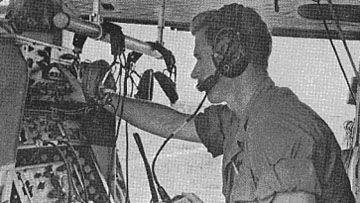 |
Page 7 TROPIC LIGHTNING NEWS August 5, 1968
ARVNs Team With CRIP To Trap VC
Locate Mortar Cache
1ST BDE - A U.S. 25th Infantry Division 1st
Brigade unit and four Vietnamese Regional and Popular Force companies made a
heliborne assault along the Vam Co Doung River, and killed 10 enemy when they
trapped an estimated Viet Cong company. The Allied forces also captured 54
enemy 82mm mortars, on the operation four miles southwest of Go Dau Ha.
The 1st Brigade’s Combined Reconnaissance Intelligence Platoon (CRIP) and the
Tay Ninh Provincial Reconnaissance Unit (PRU) assisted the Vietnamese soldiers
as they pushed into the enemy’s well-fortified stronghold.
The contact began as the fifth wave of choppers bearing CRIP and PRU soldiers
landed into ground fire. With a tremendous volume of fire the Vietnamese
charged the first woodline as the 1st Brigade unit moved to sweep the western
river bank.
Working the eastern side of the river, the four Vietnamese RF-PF companies
engaged the enemy in a 51-hour pitched battle as nine air strikes pounded the
Viet Cong’s dug-in positions.
The CRIP and PRU force came upon an uncompleted Viet Cong base, finding enemy
medical supplies and blowing two tunnels with hand grenades. The 1st Brigade
soldiers then moved through heavy undergrowth to a canal. Making use of two
sampans, the troops crossed the waterway and continued to sweep the VC-infested
area.
As a result of the operation, nine boxes, each containing six 82mm mortars
with fuzes, were discovered along the river by the CRIP as they also captured
300 pounds of polished rice and several enemy documents and destroyed five
sampans and three Viet Cong hooches.
Story, Photos By SP4 Rick Adams
 |
PROTECTIVE SMOKE - A chopper brings 25th Infantry Division soldiers into a smoke-screened landing zone. |
| HIGH AND DRY - Combined Reconnaissance Intelligence soldiers of the 25th Division seem to have a variety of styles for keeping their weapons dry as they cross a stream near Go Dau Ha. |  |
 |
YOU CAN CROSS THAT BRIDGE WHEN YOU COME TO IT - But when there’s no bridge, you have to innovate. The Combined Reconnaissance Intelligence Platoon, from the 25th Infantry Division’s 1st Brigade, uses a sampan to cross a waterway west of Go Dau Ha, in Tay Ninh Province. |
| CHARLIE’S MORTARS - An American and a Vietnamese member of the Combined Reconnaissance Intelligence Platoon (CRIP) from the 1st Brigade examine some of the 82mm mortars they uncovered on a sweep along the Vam Co Doung River in Tay Ninh Province. |
 |
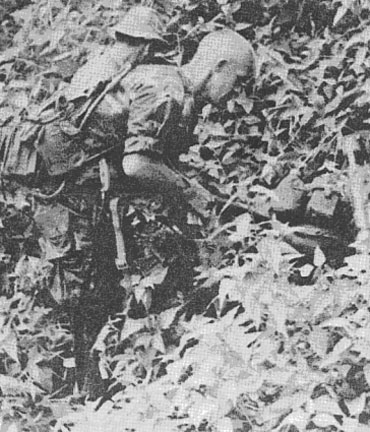 |
SEARCHING - Platoon Sergeant Walter Crutchfield (without hat) of Langdale, Ala., and two Vietnamese members of the Combined Reconnaissance Intelligence Platoon search the brush for VC after entering an enemy base camp west of Go Dau Ha in Tay Ninh Province. |
Page 8 TROPIC LIGHTNING NEWS August 5, 1968
Unit Of The Week
Wolfhounds Blazing Honor, Glory
Trails
The 27th Infantry Wolfhounds, which form the 1st and 2d Battalions celebrated
their 67th birthday on the second of May, 1968. It was no different from many
of the celebrations before. It was another birthday under fire, in combat in a
foreign land.
Volunteers of the 27th Infantry regiment were incorporated into the regular
army of the United States on the second of February, 1901, at Plattsburg
Barracks, New York.
One year later, they sailed to the Philippine Islands to put down the Moro
insurrection.
The Wolfhounds’ victory over the Moros on May 2, 1902 made that date the
official birthday of the unit.
During the early days of the 20th Century, the internal problems of Russia
became more apparent. The United States became very concerned for some private
business ventures in eastern Russia.
The regiment was deployed to Siberia in 1919 and for the following year and a
half they fought hand in hand with the White Russians against the insurgent Red
Russians. This was the first time that United States troops fought Communism.
This time of trial earned the 27th Infantry its namesake... Wolfhounds, after
the large Russian dog. The name is appropriate, for they fought the enemy with
relentless ferocity, and treated their friends with true kindness.
The year of 1920 found the Wolfhounds sailing for Hawaii to join the Hawaiian
Division.
Late in 1942 the Wolfhounds were ordered to battle in the South Pacific.
The war was finally over, and the task of occupying and rebuilding a defeated
Japan was at hand. It was here at Christmas time in 1949 that Master Sergeant
Hugh O’Reilly visited the family orphanage in Osaka, and found the children
there in such misery that he returned to the unit and asked his fellow
Wolfhounds to help the deprived young ones.
Then Korea broke out. Here, the Wolfhounds were destined to win three
Presidential Unit Citations. Their fierce fighting earned a second nickname,
the Fire Brigade.
Returning to Hawaii, the Wolfhounds participated in extensive
counter-guerilla and jungle warfare training in the rugged Koolau mountains of
Oahu. The Christmas season of 1965 saw the 27th packing their bags for the long
trip to Vietnam.
The first task was clearing the jungles for a base of operations, and the
harsh realities of war against the Viet Cong, Operations such as Cedar Falls,
Atlanta, and Quyet Thang, the crushing disintegration of the enemy’s TET
Offensive are all proof of the combat effectiveness of the 27th Infantry
Wolfhounds.
During the past 67 years the Wolfhounds have proven their right to their
motto, “We fear nothing.”
 |
HANG ON - Private First Class Merilan Henry re-enacts the half-in half-out position in which he left a rocky mountainside 1,200 feet in the air. Holding him on is Sergeant Willard R. Ethridge. Warrant Officer Stephen R. Patterson (insert) piloted his light observation helicopter three times to a perilous ledge above a Viet Cong base camp to rescue the patrol. |
Daring Rescue
Saves LRPs From Mountain
(Continued From Page 1)
“Charlie was up above us, down below us, on the right, and on the left,” said
Private First Class Roger F. VanRensselaer, 20, of Gardner, Mass.
Shortly before noon, two Huey Cobra gunships from D Troop, 3d Squadron, 4th
Cavalry, arrived and began spewing hot lead and rockets on the enemy trying to
clear the area for a helicopter extraction.
A medevac chopper arrived to get the injured man out first. There was no
clearing near the six men large enough for the slick’s big rotor blade, and the
plan was to drop a hoist for Specialist 4 Miller, 20, of Brownsville, Pa. The
pilot hovered over twice, but both times enemy fire drove him off.
Major Fred R. Michelson, 35, commanding officer of D Troop, from Clayton,
Mo., was flying command and control in the OH-6A Cayuse light observation
helicopter (LOH). He called for more fire power.
Two Cobras from the Diamondhead company of the 25th Aviation Battalion, two
Huey gunships from the 4th Cavalry squadron, and two Air Force tactical jets
soon joined the other Cobras in pounding the enemy.
A second dust-off ship with a hoist arrived. As the pilot tried to get in
close enough to drop his lift, enemy sniper fire knocked out the communications
between the pilot and the hoist operator.
To add to the bleakness, the clouds opened up, and a tropical downpour forced
the helicopters to return to the 25th Division’s base camp at Tay Ninh.
By the time the storm cleared, it was nearing dusk. Michelson decided that
the only choice was to try to resupply the patrol and hope they could make it
through the night.
The gunships again lit up the foot of the mountain with their rockets and
mini-guns as Warrant Officer Stephen R. Patterson piloted the LOH in over the
men.
Michelson leaned out on the skid and swung a bag of food, water and radio
batteries toward a granite ledge. It bounced, fell over the cliff and rolled
into the Viet Cong base camp below.
Then Patterson, 22, of Riverside, Calif., spotted a boulder in a clearing -
it was just wide enough to get one skid in.
“I hovered down and put the toe of my right skid on the rock to steady the
aircraft because of the bad updrafts. The LRP’s handed out the injured man to
Major Michelson,” said Patterson.
Having made it once, Patterson decided to take his four-seat chopper back for
the other men.
Alone this time, he again perched his bird on the rock. VanRensselaer and
Sergeant Ralph J. Hosey, Jr., 24, of Webster Springs, W.Va., leaped from the
rock to the skid and into the chopper.
“Every time they jumped on the aircraft, it would lurch, and I’d cut down a
few small trees with my rotor,” recalled the Three-Quarter Cav pilot.
Three men were left, and it was getting dark. They had one more smoke
grenade. Patterson radioed them to save it in case he didn’t make the third
try. He began hunting the mountainside for the spot. At one point he flew
right over the VC base camp but did not draw any fire.
Finally, he found the ledge and hovered in again. The men threw on their
radio and packs. Ethridge and Hitchens jumped on first. To the last man,
Private First Class Merilan Henry, 20, the tiny helicopter looked full. And
Patterson was fighting to recover the ship from a lurch caused by the weight.
“I couldn’t wait. I just dove in,” Henry said. “All I could do was throw my
feet on - the rest of my body was hanging over the side. I had my right hand up
on the pilot’s chair, and the team leader was holding on to my left hand. For a
minute I thought that was it,” continued Henry of Columbia, S.C.
With Henry hanging out the side, the LOH lifted away from the steep slope
1,200 feet up. What had looked impossible had been accomplished not once but
three times. Modestly, Patterson admitted: “It did get a little hairy there for
awhile.”
Thanks to:
Clifford Lawrence, F Company, 50th Inf.,
for sharing this issue,
Kirk Ramsey, 2nd Bn., 14th Inf. for creating this page.
This page last modified 07-14-2009
©2009 25th Infantry Division Association. All rights reserved.